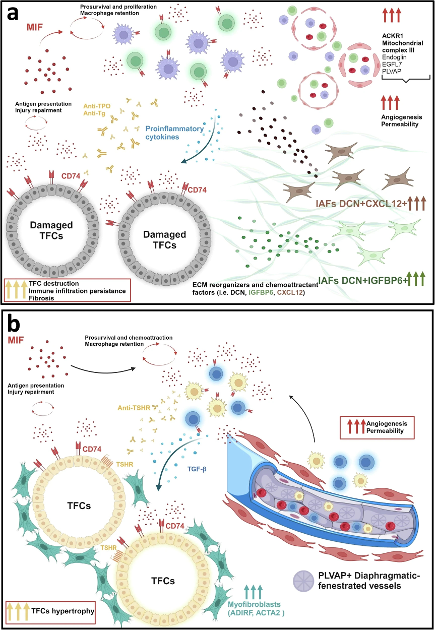This appears to be an amazing paper - if you want to understand exactly what happens, where, in Graves' Disease and Hashimoto's Thyroiditis. Incredible number of images, lots of text - needs a slightly darkened room and lots of time!
I've only just seen it so have nothing more to add at this stage.
When I view it, I see a series of images and text just below the abstract headed: Similar content being viewed by others
They might also be worth a read. 
Unraveling the molecular architecture of autoimmune thyroid diseases at spatial resolution
Rebeca Martínez-Hernández, Nuria Sánchez de la Blanca, Pablo Sacristán-Gómez, Ana Serrano-Somavilla, José Luis Muñoz De Nova, Fátima Sánchez Cabo, Holger Heyn, Miguel Sampedro-Núñez & Mónica Marazuela
Nature Communications volume 15, Article number: 5895 (2024)
Abstract
Autoimmune thyroid diseases (AITD) such as Graves’ disease (GD) or Hashimoto’s thyroiditis (HT) are organ-specific diseases that involve complex interactions between distinct components of thyroid tissue. Here, we use spatial transcriptomics to explore the molecular architecture, heterogeneity and location of different cells present in the thyroid tissue, including thyroid follicular cells (TFCs), stromal cells such as fibroblasts, endothelial cells, and thyroid infiltrating lymphocytes. We identify damaged antigen-presenting TFCs with upregulated CD74 and MIF expression in thyroid samples from AITD patients. Furthermore, we discern two main fibroblast subpopulations in the connective tissue including ADIRF+ myofibroblasts, mainly enriched in GD, and inflammatory fibroblasts, enriched in HT patients. We also demonstrate an increase of fenestrated PLVAP+ vessels in AITD, especially in GD. Our data unveil stromal and thyroid epithelial cell subpopulations that could play a role in the pathogenesis of AITD.
Open access to full paper:
nature.com/articles/s41467-...
Suggestion:
I suggest reading the abstract and the discussion. Going back to the rest as and when you feel a desperate urge to do so!
Abbreviations:
As I come across unusual or difficult acronyms/abbreviations, I'm adding them below to help anyone trying to read the paper!
ADIRF = Adipogenesis Regulatory Factor
DCN = decorin
ECM = extracellular matrix
IAF = inflammatory associated fibroblasts
MIF = macrophage migration inhibitory factor
PAX8 = Paired box gene 8, is a protein which in humans is encoded by the PAX8 gene.
PCA = Principal Component Analysis
PLVAP = Plasmalemma Vesicle Associated Protein
SMA = smooth muscle actin
SMC = smooth muscle cells (SMCs)
TAGLN = Tagln OE /Tagln sh fibroblasts
TDS = Thyrocyte Differentiation Score
TFC = thyroid follicular cells (TFCs)
TIL = thyroid infiltrating lymphocytes (TILs)
UMAP = Uniform Manifold Approximation and Projection

